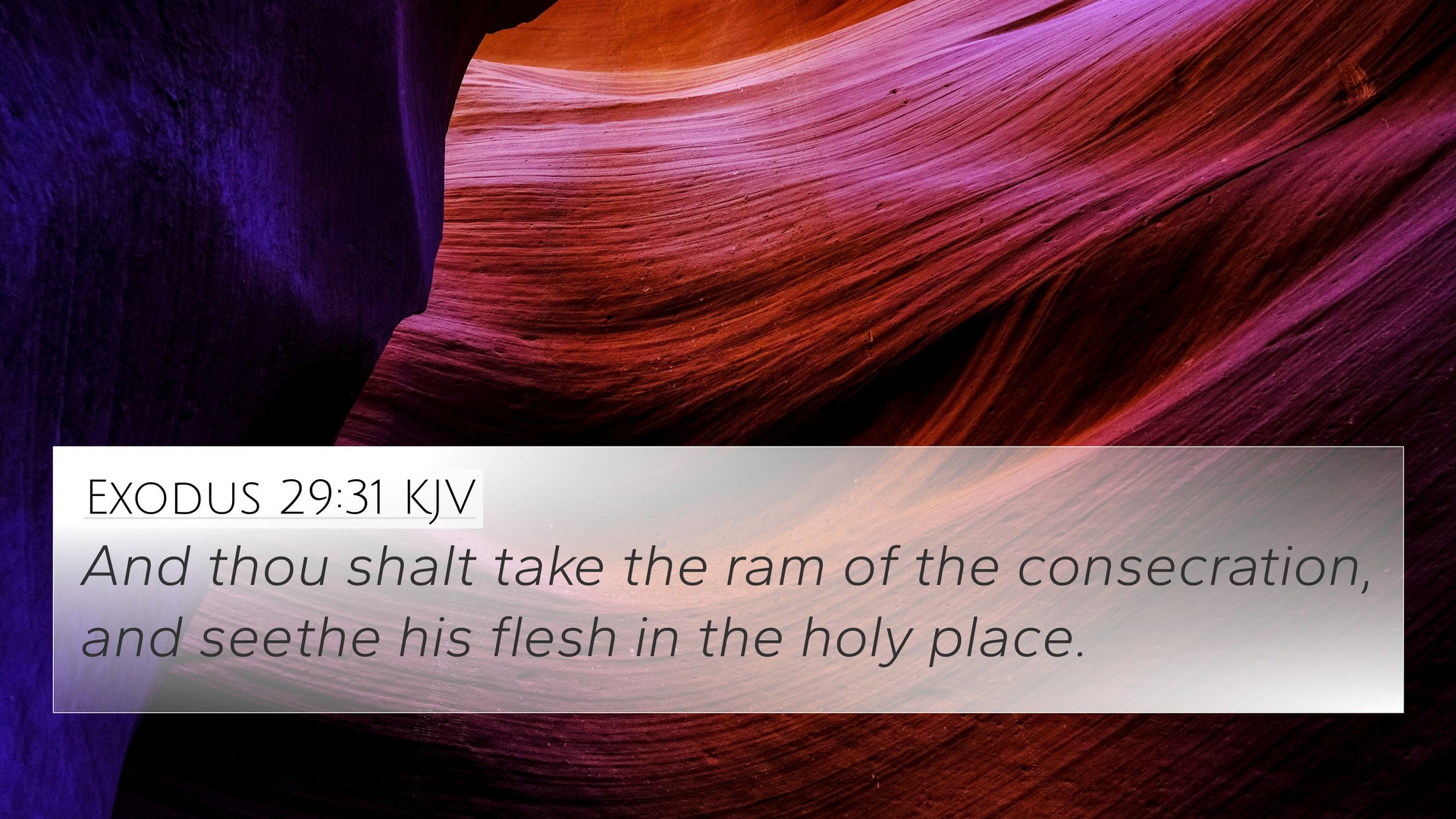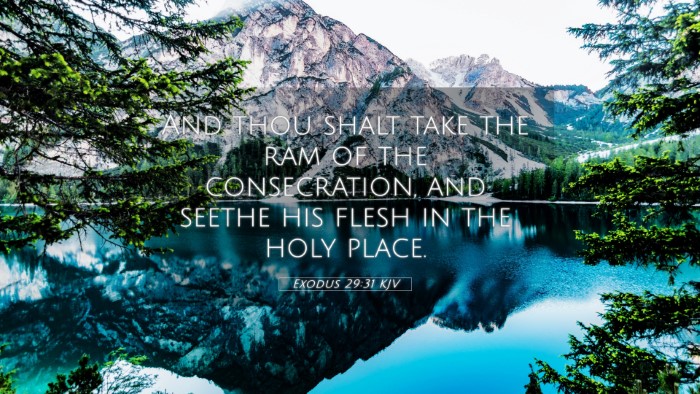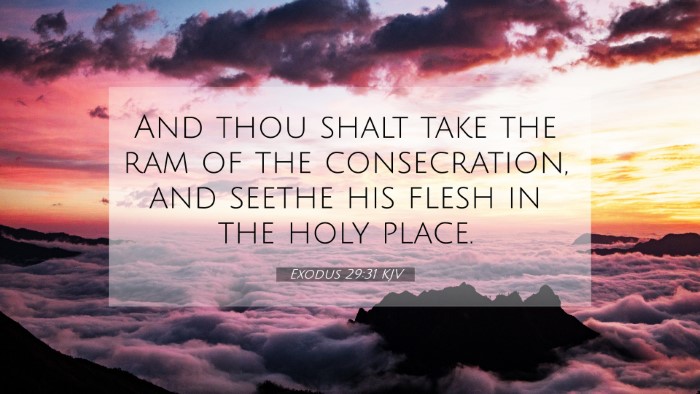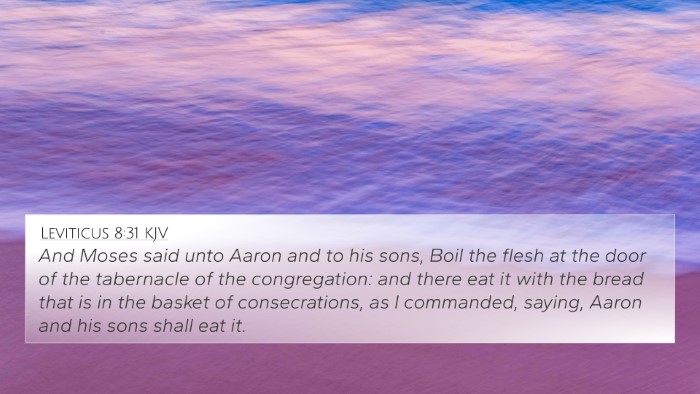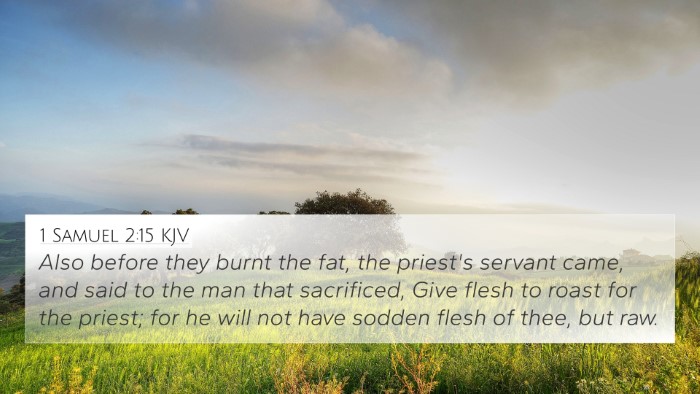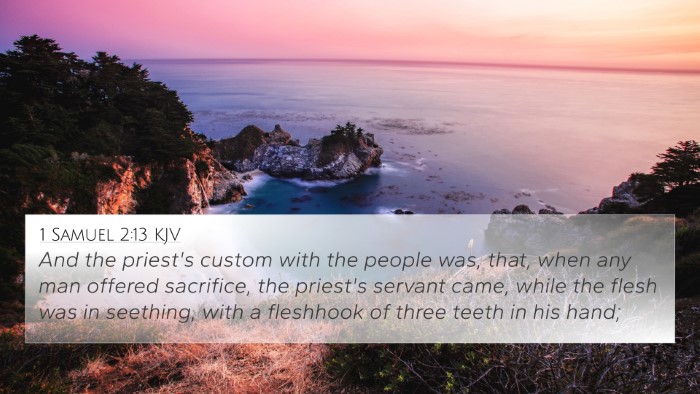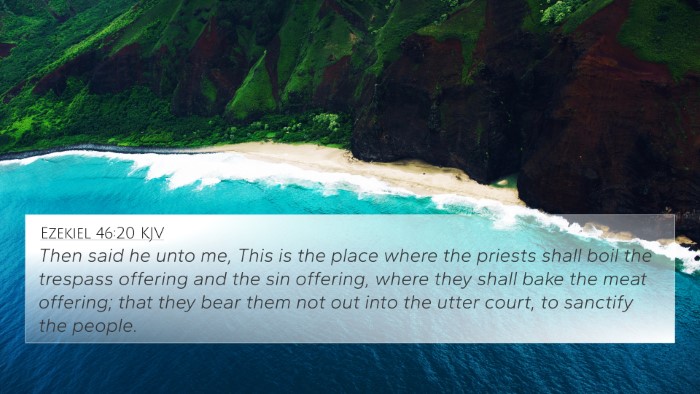Understanding Exodus 29:31
Exodus 29:31 reads: "And thou shalt take the ram of the consecration, and seethe his flesh in the holy place." This verse is part of the instructions given to Moses regarding the consecration of Aaron and his sons as priests.
Significance of the Verse
The command to seethe the ram's flesh in the holy place highlights the sanctity of the priestly ordination and emphasizes the importance of approaching God with a profound sense of reverence. Throughout the public domain commentaries, we find several insights:
- Matthew Henry emphasizes that the act of boiling the ram signifies the purification and dedication required for the priests; it denotes the serious commitment to their sacred duties.
- Albert Barnes notes that the 'holy place' is critical, as it illustrates the appropriate setting for sacred acts, underlining the separation of holy from the common, thus associating the act with divine approval.
- Adam Clarke reflects on the significance of the ram itself, suggesting it symbolizes the atonement and the willingness of both the priests and the congregation to submit to God's requirements.
Connections with Other Bible Verses
Exodus 29:31 connects with multiple verses throughout Scripture, creating a network of understanding regarding sacrifices, priestly duties, and divine holiness.
- Leviticus 8:18-22: This passage further elucidates the ordination of priests and involves similar sacrificial practices, reinforcing the significance of consecration.
- Hebrews 5:1-3: The New Testament perspective emphasizes the role of priests, indicating how they are appointed to act on behalf of men in relation to God.
- 1 Peter 2:9: This verse highlights the idea of believers as a royal priesthood, drawing parallels between the Old Testament practices and the New Testament church.
- Romans 12:1: Paul urges believers to present their bodies as living sacrifices, linking the concept of sacrifice to the act of worship and dedication to God.
- John 1:29: Jesus is identified as the Lamb of God, which relates the themes of sacrifice in Exodus to the ultimate sacrifice for humanity’s sins.
- Isaiah 53:7: This prophetic verse speaks of the suffering servant, drawing connections to sacrificial themes found in Levitical rites.
- Exodus 30:10: The atonement and preparation of the altar also contribute to our understanding of holiness and consecration in service.
- Numbers 18:8-9: This depicts the duties of the priests concerning offerings, linking the themes of service and sanctification directly.
- Ephesians 5:2: This highlights how Christ's sacrifice brings a new understanding of love and offering to God, transforming Old Testament principles.
- Hebrews 10:11-14: Acknowledges the finality of Christ's sacrifice as fulfilling the sacrificial system, showing the progression from the Old to the New Covenant.
Thematic Analysis
Thematically, Exodus 29:31 portrays the holiness of God and the required reverence in worship. In understanding these ancient practices, we see a broader narrative woven through Scripture:
- Holiness: The priest’s consecration is a reminder of God’s holiness and the necessity for purification before approaching Him.
- Sacrifice: The act of boiling the ram emphasizes God's requirement for sacrifices, a theme that recurs throughout the Bible.
- Dedication: This verse invites reflection on the dedication needed in our worship and service, paralleling how New Testament believers are called to live sacrificially.
- Atonement: Connecting this ordinance to later scriptural references on atonement reveals how these practices pointed towards the ultimate sacrifice of Christ.
- Service: Understanding this verse through a lens of service helps illuminate New Testament teachings on the role of the believer as a servant of God.
Tools for Cross-Referencing and Further Study
For those interested in deeper explorations of biblical cross-references, there are numerous tools to assist:
- Bible Concordance: A useful resource for finding specific words and their occurrences throughout Scripture.
- Bible Cross-Reference Guide: Helps in navigating the interconnectedness of passages, unveiling thematic links.
- Cross-Reference Bible Study: Engaging in systematic studies that utilize cross-referencing aids in enhancing understanding.
- How to Use Bible Cross-References: Guides on effectively tracing themes and ideas throughout both Old and New Testaments.
- Bible Chain References: A method of studying that connects a series of verses on related topics for an integrated view.
- Comprehensive Bible Cross-Reference Materials: Resources that compile links and themes across various books of the Bible for more thorough study.
Conclusion
In conclusion, Exodus 29:31 serves as a vital piece in understanding the broader themes of sacrifice, holiness, and the priestly role in both the Old Testament and its implications for New Testament believers. Through careful cross-referencing and thematic studies, we gain insights into how this verse connects with other Scriptures and invites us to reflect on our own relationship with the divine.
